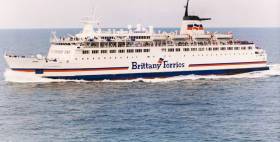Displaying items by tag: Duc de Normandie
#FrenchDucVisit – On this date a quarter of a century ago, a Brittany Ferries ship made a once-only visit to Cork, a unique event in Irish ferry terms which was personally observed, writes Jehan Ashmore.
The 1500 passenger/350 vehicle ferry Duc de Normandie was seen sailing into Cork Harbour on 28 March 1992, having sailed overnight from Roscoff, Brittany. To add to the unique occasion the arrival of the business-like yet handsome looking ferry was noted when entering the neck of the lower harbour. This was noted from the elevated site of the former Fort Camden beyond Crosshaven.
The site now officially named Fort Meagher also affords views to its counterpart Fort Carlisle (Fort Davis) on the opposite side of the harbour. Further south along that side of the coast is the iconic landmark of Roches Point Lighthouse.
As an avid ferry enthusiast, the course of the Duc de Normandie was keenly traced as the former Dutch ferry (Prinses Beatrix) gently weaved further into the expanse of the natural harbour, yet a route that is dictated by the channel beneath. By the time the ferry was between Whitegate Oil Jetty and Spike Island, it was decided to depart this vantage point and head to Ringaskiddy Ferry Terminal.
Upon arrival in Ringaskiddy, the distinctive sound of 'live' Breton traditional musical was clearly heard within the grounds of the ferry terminal. Reasons as to why soon transpired as a wedding celebration was underway. It was nice to see such an occasion and how the seasonal ferry link gave an example in connecting Celtic traditions between the Irish and Bretons.
It should however be noted that this now historic visit by Duc de Normandie, which was made early into the seasonal service of 1992 had followed the opening sailing. This saw the deployment of a chartered but former Brittany Ferries ship, Cornouailles.
This would not be a conducive return to Cork of the ferry renamed Havelet of British Channel Island Ferries. Following a late arrival, Havelet set off on the return crossing to Roscoff but a freak wave struck the Norwegian custom-built ferry.
The incident caused a serious listing and damage on the vehicle decks. This led to the Havelet having to turn around and head back to Cork for repairs. Two days after the terminated sailing the ferry departed after repairs, however this caused a row with the Department of the Marine who claimed that enquires into the incident were not completed.
To replace Havelet on the Ireland-France service this led to this first and only visit of the Duc de Normandie, however it would be Quiberon that would take over the shoulder months that season. The Quiberon been no stranger to the continental route having entered service in 1982 on a route that was established almost four decades ago in 1978 by the Armorique.
As for the high-season summer months of 1992, they were carried out by the then flagship Bretagne. The first custom built 'cruiseferry' for Brittany Ferries entered service in 1989. She was designed to operate Spanish and English Channel routes in addition to serve the seasonal duties of the Irish route.
There have been other once-off callers from the Brittany Ferries fleet but they were deployed during the earlier years of the route. Asides Duc de Normandie, the most recent once-off caller was Bretagne albeit having served the route until 2004, the cruiseferry made a return visit to Cork two years later.
On that occasion, a trip was made to see the Bretagne make an arrival and departure in October 2006. The reason was that routine flagship, Pont-Aven was on charter for the Route du Rhum yacht event.
Pont-Aven as Afloat recently reported was deployed on St. Malo-Portsmouth duties in tandem with routine ship, Bretagne. The Cork-Roscoff regular, Pont-Aven is scheduled to resume the seassonal service this week.
The first sailing from France departs Roscoff on Friday, 31 March and the corresponding return sailing from Ireland departs on Saturday, 1 April.






























































